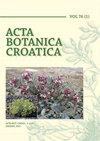Indications of programmed cell death in wheat roots upon exposure to silver nanoparticles
IF 1.1
4区 生物学
Q3 PLANT SCIENCES
引用次数: 0
Abstract
Programmed cell death (PCD) can occur at every developmental stage as a plant’s response to various biotic and abiotic environmental factors. Silver nanoparticles (AgNPs) are widely used in consumer products and possess antimicrobial properties, making them important in assessing nanoparticle effects on plants. In the present study, we examined the impact of AgNPs (0, 0.5, 1, 5, 10, and 20 mg L-1) on wheat root PCD by evaluating parameters such as the mitotic index, chromosomal behaviors, nuclear deformation, cytochrome c release, caspase-1-like activity, and the expression of cysteine protease genes (TaVPE4, TaMCA1, and TaMCA4). Our findings revealed a dose-dependent decrease in the mitotic index ratio and increased chromosomal abnormalities induced by AgNPs. Additionally, we observed various hallmarks of PCD, including chromatin condensation, slight DNA smear, reduction in mitochondrial inner membrane potential, and cytochrome c release to the cytoplasm as well as increased caspase-1-like activity and TaVPE4 gene expression. Notably, the gene expressions of TaMCA1 and TaMCA4 were found to be antagonistically regulated by AgNPs, further indicating the induction of PCD by AgNP treatment. Overall, our study provides evidence of AgNP-induced PCD in wheat roots, elucidating the involvement of cysteine protease genes in this process.暴露于纳米银粒子后小麦根部细胞程序性死亡的迹象
作为植物对各种生物和非生物环境因素的反应,程序性细胞死亡(PCD)可能发生在植物的每个发育阶段。银纳米粒子(AgNPs)被广泛应用于消费品中,具有抗菌特性,因此在评估纳米粒子对植物的影响时非常重要。在本研究中,我们通过评估有丝分裂指数、染色体行为、核变形、细胞色素 c 释放、类 caspase-1 活性以及半胱氨酸蛋白酶基因(TaVPE4、TaMCA1 和 TaMCA4)的表达等参数,研究了 AgNPs(0、0.5、1、5、10 和 20 mg L-1)对小麦根系 PCD 的影响。我们的研究结果表明,AgNPs 会导致有丝分裂指数比呈剂量依赖性下降,并增加染色体异常。此外,我们还观察到 PCD 的各种特征,包括染色质凝结、轻微的 DNA 涂片、线粒体内膜电位降低、细胞色素 c 释放到细胞质以及 caspase-1 样活性和 TaVPE4 基因表达增加。值得注意的是,TaMCA1 和 TaMCA4 的基因表达受 AgNPs 的拮抗调控,这进一步表明 AgNP 处理诱导了 PCD。总之,我们的研究提供了 AgNP 诱导小麦根系 PCD 的证据,阐明了半胱氨酸蛋白酶基因参与了这一过程。
本文章由计算机程序翻译,如有差异,请以英文原文为准。
求助全文
约1分钟内获得全文
求助全文
来源期刊

Acta Botanica Croatica
PLANT SCIENCES-
CiteScore
2.50
自引率
0.00%
发文量
34
审稿时长
>12 weeks
期刊介绍:
The interest of the journal is field (terrestrial and aquatic) and experimental botany (including microorganisms, plant viruses, bacteria, unicellular algae), from subcellular level to ecosystems. The attention of the Journal is aimed to the research of karstic areas of the southern Europe, karstic waters and the Adriatic Sea (Mediterranean).
文献相关原料
| 公司名称 | 产品信息 | 采购帮参考价格 |
|---|
 求助内容:
求助内容: 应助结果提醒方式:
应助结果提醒方式:


